2008 OLYMPICS IN BEIJING
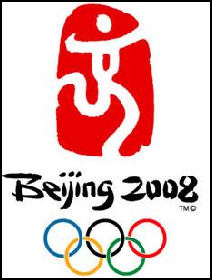 The Olympics in Beijing ran from August 8 — the 8th day of the 8th month — to August 24, 2008 with the Opening Ceremonies beginning at 8:08pm on August 8th. Eight is lucky number in China. Hosting the Olympics in 2008 was regarded as auspicious as well as an honor. The Olympic slogan was “One World, One Dream.” More than 16,000 athletes from 205 countries and territories took part in 28 sports. The gold, silver and bronze medals incorporated double dragon loops of jade.
The Olympics in Beijing ran from August 8 — the 8th day of the 8th month — to August 24, 2008 with the Opening Ceremonies beginning at 8:08pm on August 8th. Eight is lucky number in China. Hosting the Olympics in 2008 was regarded as auspicious as well as an honor. The Olympic slogan was “One World, One Dream.” More than 16,000 athletes from 205 countries and territories took part in 28 sports. The gold, silver and bronze medals incorporated double dragon loops of jade.
Many Chinese were extremely happy that Beijing got to host the games in 2008. In a 2001 survey, 95 percent of Beijingers said they supported the Olympics. As an expression of enthusiasm several thousands parents named their child Aoyun, Chinese for “Olympics,” and several thousand more named their children after the Olympic mascots. There was a competition among some parents to see who could give birth to a child at 8:08pm on August 8th 2008 — the exact time the Olympics begin. One man told the China Daily, “If my wife is lucky enough to deliver an “Olympic baby,” the luck means something more than family joy.”
Beijing expected 500,000 foreign tourists but only 389,000 came, including those from Hong Kong, Macao and Taiwan. Over 1 million Chinese visitors descended on Beijing for the games, which were held during one the hottest, most humid and most polluted months of the year. Around 4 billion people watched on television’the largest audience for any event ever. Organizers hoped that games could attract $1 billion in sponsorship money, $700 million from corporate sponsors and $300 million from the IOC. A total of $40.9 billion was spent on sport facilities and infrastructure, far more than any other Olympics.
Chinese officials claim the Olympics made a $146 million profit.
See Articles Under OLYMPICS factsanddetails.com ; Beijing Olympics site en.beijing2008.cn ; Olympic.org olympic.org ; China.org on the 2008 Games china.org.cn ; Chinese Olympic Committee en.olympic.cn ; China’s Olympic History china.org.cn ; Book: “Olympic Dreams: China and Sports, 1895-2008" by Xu Gouqi
Significance of the Beijing Olympics in 2008
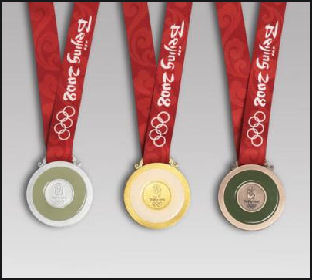
back of medals The Beijing Olympics were more than just a sporting event. Many saw them as redemption for China, signaling China’s emergence as a superpower, representing the end of the “century of humiliation” at the hands of foreigners and signaling the start of the Chinese century in which China and the Chinese would command respect from the world community.
Many also saw the event as a defining moment in China’s history and development — a kind of coming of age ceremony for China the same way the Olympics at Tokyo in 1964 were coming of age ceremony for Japan and the Olympics in Seoul in 1988 were a coming of age ceremony for South Korea in 1988.
The only difference is that in 2008 we're talking about China the most populous and arguably the oldest nation in the world, and one that has suffered from 50 years of isolation under Maoism and before that suffered nearly 200 years of humiliation at the hands of foreigners. A great deal of money, time and effort is going into preparing Beijing for the event and preparing athletes to perform well. Over $40 billion has been spent to get Beijing ready — three times more than any other Olympics. Some think that China will win the most medals.
Records Set at the Beijing Olympics in 2008
Athletes from a record 87 nations won medals in Beijing, compared to 80 in Sydney in 2000,the previous record holder. A record 43 world records and 132 Olympic records were broken in Beijing compared to 34 world records and 77 Olympic records broken in Sydney in 2000, again the previous record holder.
The Beijing Olympics were by far the most expensive Olympics ever at $43 billion, compared to $12.7 billion for Athens. Twice as much was spent on the Beijing Games as the previous two Olympics combined. It is very unlikely that more will be spent on the London Olympics in 2012.
Beijing was the most watched Olympics on television ever. It drew 214 million viewers in the United States, compared to 209 million for the Atlanta Games in 1996, the holder of the previous record.
Sports at the 2008 Olympics
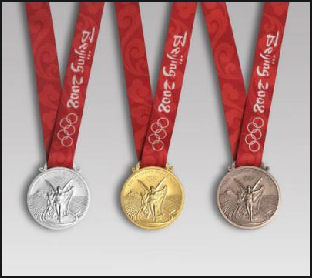
front of medals
At the Beijing Games there were 302 events in 28 sports, with around 1,000 medals given out (in some sports such as boxing two bronze medals are given). BMX debuted in 2008 as an Olympics sport. New events including the women’s steeplechase and the women’s sabre team fencing event. Softball appeared for the last time.
The Chinese repeatedly asked the IOC for approval of wushu as an Olympics sport but was denied each time. Some felt this was unfair in that the Japanese sport of judo was made an Olympic sport when Tokyo hosted the games in 1964 and the Korean sport of tae kwon do was made an Olympic sport when Seoul hosted the games in 1988.
An unofficial wushu tournament was held. Medals were given out in the event that were exactly like the real ones except they didn’t have the engraved Olympic emblems. Athletes that won them said things like “it feels like I’m taking part in a real Olympic event.” Participants were allowed to stay at the Olympic Village. This led some to call the competition a “fake Olympic event.”
Olympic Medals, Logo and Mascots in 2008

On one side of the gold, silver and bronze medals was an engraving of the winged goddess Nike and the Panathinikos arena in Greece. The other side was inlaid with jade and had the Beijing emblem engraved on the metal centerpiece. White jade was used in the gold medal, light green in the silver and dark green in the bronze.
Entitled the “Chinese Chop, Dancing Beijing,” Olympic seal combined the Chinese chop and the art of calligraphy with a sports figure that looks as if he is crossing the finish line in victory. The figure represents the Chinese character “Jing,” which stands for Beijing and is part of the saying “Is it not a joy to welcome friends from afar’” The Red is both a traditional Communist and traditional Chinese color.Many Chinese didn’t like it. On a Internet chat site, one person wrote: “the figure looks so weak. The legs are soft and limp, like a eunuch trembling before his master.” Another said, “It doesn’t represent China well. It looks like a hunched-over female servant.”
The five Olympic mascots were Jing Jing the panda; Ying Ying the chiru (a Tibetan antelope); Bei Bei the fish; Ni Ni the swallow; and Huan Huan the Olympic flame. Collectively they were known as “the Five Friendlies.” The first characters of each name — Bei, Jing, Huan, Ying and Ni — form the expression “Beijing Huanying Ni” which means “Beijing Welcomes You.” The Friendlies also represented the five elements of nature — the sea, forests, fire, earth and sky — and the five traditional blessings — prosperity, happiness, passion, health and good luck. Each mascot was the color of one of the Olympic rings. According to the official Beijing Olympics website Jingjing is “charmingly naive and optimistic.” The mascots were everywhere in Beijing. Sales of 200 products with the mascots on them went on sale soon after the characters were unveiled.
Media and the Internet and the 2008 Olympics in Beijing
There were originally plans to block politically-sensitive websites such as those run by Amnesty International available to reporters in the Olympic press center. In the end complains by foreign reporters and the IOC led to the lifting of blocks on some sites but other sites like those connected to Falun Gong and the Tibet government-in-exile remained blocked.
The 21,600 accredited journalists worked out of the Press and Broadcast Center which had a record 1.6 million square feet of workspace, rows and rows of brand-new computers and thousands of English-speaking volunteers anxious to do whatever was asked of them with big smiles.
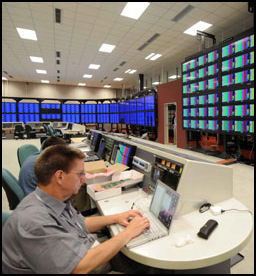
media center The media centers were about twice the size they needed to be. Sometimes a single reporter rode in 32-seat media buses, which were given access to express lanes on major roads. Other times dozens of buses made their runs with nobody on them at all. Most of the press rooms offered free Oreo cookies and Ritz crackers. The brand names of the toilets in the press area and engines of press boats in the sailing center and anything that was not an official Olympics product had its name covered.
Many press offices had televisions that received feeds from all the Olympic venues and literally had coverage of every event as they happened. But getting a simple answer to a question was often next to impossible, requiring the question asker ro fill out a pile of papers and wait for a couple days for answer that never came.
Reporters stayed in spacious rooms in the Green Homeland Media Village that were sold as condominiums after the Games, Those that stayed on the media buses and stayed within security perimeters went through a single security check when they left the media village and didn’t have to endure further security checks at the event sites.
China was put under the microscope during the Olympics and many foreign newspapers and media outlets were sharply critical of China on a number of issues but for the most part said positive things. When asked about the legacy of the games, IOC President Rogge said,, “China was scrutinized by the world. China has learned about the world and the world has learned about China. I think this will have a positive long-term affect.”
The Chinese government — apparently worried about protests — decided to bar live coverage from Tiananmen Square during the Olympics. The plans ran counter to plans by international television networks to have live shots from famous landmarks in China and showed the Chinese government was worried about protests. The move was seen by some as blemish on Beijing’s promise to the International Olympic Committee that the games would promote “openeness” in China.
Plans to control media coverage from Tiananmen Square were largely futile. Foreign journalists largely ignored the rules that required them to register before working in the square. Police and paramilitary officers in plain clothes kept an eye on them and were careful to avoid making a scene when small protests were staged in the square.
Television Coverage and the 2008 Olympics in Beijing
Record television viewing audience watched the Olympics in China. More than 840 million people watched at least a minute of the Opening Ceremonies on China Central Television (CCTV). By some counts it was the largest television audience in history for a single event on a single television station.
Surveys by Neilssen Media indicated that up to 96 percent of Chinese household with televisions tuned into some portion of the Olympics, which were shown on seven channels. More than 100 million people tuned into to CCTV’s website to watch the Olympics.
There were spectacularly high ratings in China for events like gymnastics, soccer and even weightlifting. The rating for women’s volleyball were particularly with viewership for a the China-Poland game reaching 372 million. More than 330 million watched the women’s table tennis gold medal match. About 170 million watched the China-United States basketball game. A women’s weightlifting contest drew 155 million viewers.
CCTV broadcast 2,900 hours of Olympics programing during the Games and paid about $17 million for exclusive broadcast rights in China and earned more than $400 million in advertising revenues from ads that cost 200 percent to 400 percent more than ads broadcast at other times.
The International Olympic Committee (IOC) earned $1.74 billion in broadcast revenues for the Beijing Games in contrast to $1.2 million for the first televised Games in Rome in 1960. The European Broadcasting Union, a conglomerate of dozens of national broadcasters, obtained their rights to the Beijing Games for $443.4 million.
NBC Coverage and the 2008 Olympics in Beijing
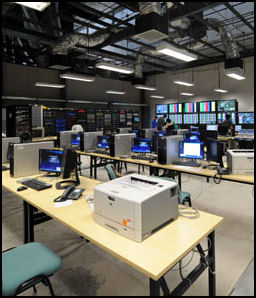
media center
NBC delivered 3,600 hours of coverage if all of its networks and websites were included — 1,000 hours more than coverage of all the Summer Olympics before 2008 combined. An average of 212 hours of programming was broadcast each day on seven television networks: NBC, MSNBC, CNBC, USA, Oxygen, Telemudo and Universal HD, with 75 percent of the coverage live. The remainder was on NBCOlympics.com.
NBC recorded a record of 107 million viewers for the Opening Ceremonies, near that for Michael Phelp’s 8th gold medal and average prime time audiences off 29 million, all records of a foreign Olympics. It paid $894 million for broadcast rights and earned over $1 billion in advertising revenues.
NBC paid $894 million for the right to cover the Olympics in Beijing as part of a $2.3 billion deal to cover the Olympics in Athens in 2004, Turin in 2006 and Beijing in 2008. NBC bid for the games in 1995 before Beijing had been chosen as host. It plans to produce 3,600 hours of coverage for its television stations and websites.
Some marquee events — such as all the swimming finals and many of gymnastics finals — have been scheduled in the early morning to cater to U.S. prime time television audiences — a decision made by the IOC, who has been sharply criticized for caving into demands of American television broadcasters.
Olympic Sponsors in 2008
The twelve Games partners that have marketing rights to use the Olympics logo globally are McDonald’s, GE, Atos Origin, Johnson & Johnson, Kodak, Lenovo, Manulife, Omega, Panasonic, Samsung, Coca-Cola and Visa. These companies have spent tens of millions of dollars on their ad campaigns and signed contracts that gave them few options other than stay the course even when troubling events like the protests in Tibet appeared on the radar.
On politics and the Olympics, a Samsung spokesman said, “We believe the Olympic Games are not the place for demonstrations, and we hope that all people attending the games recognize the importance of this.” Coca-cola said it would be inappropriate “to comment on the political situation of individual countries.” and said the “Olympics are a force of good.” Lenovo at one point said it was following the events in Tibet “with concern and regret.”
Olympic Village and Facilities for Athletes at the 2008 Olympics
The Olympic Village housed 16,000 athletes and officials. The heavily guarded compound contained 42 newly-built apartments blocks that were capable of housing 17,000 people in 9,000 rooms, most of which didn’t have televisions. Some star athletes such Shawn Johnson and Nastia Liukin shared a room in the village rather than stay at pricy hotels. Even some VIPS like IOC President Jacqes Rogge stayed at the village.
A typical Olympics Village unit was comprised of a central living room surrounded by three or four bedrooms The rooms were decorated with copies of Tang Dynasty statues, photos of Beijing and traditional Chinese wall hangings and calligraphy.
Facilities in the village included a center where athletes could learn Chinese and folk arts like kite making. Th central courtyard staged wushu demonstrations. The food was served in all-you-can-eat buffet style with 30 percent of the dishes Chinese style and 70 percent Western style. A total of 1,200 people were utilized to respond to any problems or request that athletes had at any time. Forty students with first rate language skills from China’s best universities were recruited just for laundry reception
Food was available 24 hours a day. At its peak 80,000 meals a day were served. On the food, Japanese gold-medal-winning breaststroker Kosuke Kitajima said, “Compared with the other two Olympics I’ve taken part in, the food was te tastiest.”To make sure a Munich-style attack didn’t occur, the village was enclosed by a wall and two lines of high security fencing and strict credential and bag checks were carried out for anyone entering the area.
The United States Olympic Committee established a $3 million training-recreation center for athletes at Beijing Normal University. It was designed as place where athletes could relax, get some quiet and find at atmosphere and training facilities like they were used to at home. At a training facility for American track and field athletes in Dalian many athletes came down with food poisoning. No one was sure what the cause was. Possible culprits: contaminated tap water used to wash lettuce and locally-purchased cooking oil.
Over 100,000 condoms were kept in stock at the Olympic Village clinic, where they given free to athletes. About 10,500 athletes stayed in the village, which means there were 9.5 condoms available per athlete.
There were rumors of doping rings being active in the Olympic village.
Solar power cut carbon dioxide emissions by 8,000 tons. Solar power heated 90 percent of the water used in showers and baths. Units had extra insulation and double-glazed, Low-E glass to conserve energy. Wastewater from the sewage system was recycled and used to water plants.
Religion and the 2008 Olympics
Many religious-minded athletes were dissatisfied with the religious center, which boasted facilities for Protestants, Catholics, Buddhists and Muslims with 10 religious aides speaking English or Arabic. Foreign chaplains were banned and Christian athletes complained that services conducted by state-employed pastors or students volunteers were carried out in broken English and other foreign languages. Muslims had similar complaints about the Islamic center.
Athletes were allowed to bring one Bible into the country for personal use. If they forget it, the Chinese government provided them with one, with an Olympic logo on it, for free.
Bibles were given free to athletes, tourists and spectators. About 10,000 bilingual copies were distributed at the Olympic Village. Most of the others were given out at official state churches. Authorities took away 300 Bibles from four Americans who had plan to distribute them.
Money, Parties Sponsors, Business and the 2008 Olympics

Coke bottle art There were 63 official Olympics sponsors for the Beijing Olympics. They provided an estimated $866 million in revenues, goods and services, representing 40 percent of the IOC’s overall intake.
Lenovo was the biggest Chinese sponsor of the Games. It was a co-sponsor of the torch relay and designed the striking scroll-like Olympics torch. It also provided more than 10,000 pieces of computing equipment and 500 engineers to help deliver data and results from more than 300 events to the media and audiences around the world.
Most sponsors hosted parties and events for potential customers, had booths of various kinds and got lots of tickets to Olympic events. Some sponsored accompanied the torch relay sending out mini-skirted cheerleader to hand T-shirts with corporate logs.
GE provided water and power systems for the Olympics to showcase its technology. It announced that it had exceeded its sales goal for the Beijing Games, winning 400 infrastructure projects in and around Beijing worth about $700 million.
Adidas hosted a party with 800 people, including the actor Jet Li and former Olympians Ian Thorpe and Nadia Comeneci. The fashionable developers Pan Shiyi and Zhang Xin hosted a party for over 1,000 of their best fiends and business contact at the Commune at the Great Wall. Among those in attendance were media tycoon Rupert Murdoch and his wife Wendi Deng, Baidu.com CEO Robin Li, music producer Quincy Jones and the actress Maggie Cheng and her boyfriend German architect Ole Scheerem, one of the designers of the iconic CCTV headquarters.
Tape was placed over the names of nonsponsor companies all over town on everything from soaps to fire alarms to toilets.
Tragedies at 2008 Olympics in Beijing
On the first day of competition, a Chinese man wielding a knife attacked an American couple at the Drum Tower, an ancient structure in central Beijing, killing the man and wounding his wife and their Chinese guide. The attacker, a 47-year-old unemployed man named Tang Yingming from Hangzhou in Zhejiang Province, then killed himself by leaping 130 feet from the tower, leaving behind, one witness said, a “lot of blood,” which was quickly cleaned up.
The victims were Todd and Barbara Bachman, the parents of former U.S. woman’s volleyball player Elisabeth “Wiz” Bachman, a member of the 2004 Olympic team, who is married to the coach of the 2008 American men’s volleyball team, Hugh McCutcheon. Todd Bachman died. Elisabeth Bachman was with her parents at the time but was not hurt. Barbara Backman underwent eight hours of surgery. She received a message from U.S. President Bush and was visited by a high level Chinese official. Tang lost his job a few years before. After that his marriage broke up and he became depressed about that his wastrel son but still no one who knew ever thought he would kill two strangers and then kill himself.
After the drum tower stabbing security was beefed up. Two small tanks were placed outside the offices for print journalists. The team that McCutcheon coached went on to win the gold medal in mn;s volleyball.
A few days earlier a New Zealand reporter was attacked and slightly injured by a young man wielding a broken chair. But other than they were surprisingly few reports of violence or crime, directed at foreigners or Chinese, during the Games. The only other report of Olympic visitors being hurt was in a crash between a bus from he Athlete’s Village and a van on its way to the Olympic rowing park that left one Croatian coach hospitalized and three Chinese in critical condition.
A Chinese dancer was badly injured during rehearsals for the Opening Ceremonies. See Opening Ceremonies
Controversies at the 2008 Olympics
In a photo that was taken in a pre-Olympic advertisement for a courier company that sponsored the Spanish sports federation the Spanish basketball team used their index fingers to pull back the corners of their eyes to make their eyes looks slanted like those of Chinese. Americans seemed more offended than Chinese. Many Spanish saw the picturers as playful but not offensive.
There were surprisingly few drug scandals. The only high-profile athlete to have a positive test was Lyudmilla Blonska of Ukraine who was stripped of her silver medal in the heptathlon and forced out of the long jump final. Many those who had positive tests had them before the Games even started. Among Chinese athletes, wrestler Luo Ming and swimmer Quyang Kumoeng tested positive for banned substances in the weeks before the Games and they and their coaches were barred for life from their sports.
The China Anti-Doping Agency conducted 5,007 tests in 2008 before the Olympics. Eight Chinese athletes, including six on the provincial level, tested positive. About 70 percent of the tests were done out of competition when athletes are most likely to use banned substances.
Chinese athletes were given an hour’s notice before their tests, which experts say is enough time to alter a sample. If nothing else they can drink enough water to dilute their urine sufficiently to avoid a positive result. There are also stories of athletes doing things like ingesting laundry detergent to mask the effects of EPO.
See Opening Ceremonies
Impact of the 2008 Olympics on Beijing
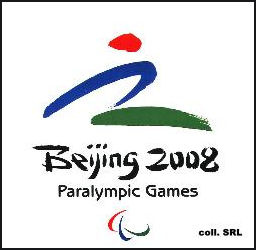
The Olympics were applauded in China as the “best games ever.” The IOC called them an “indisputable success,” that brought improvements in the areas of media freedom, the environment and public health to China and attracted broader participation and a larger audience than any other Olympics. This assessment angered many human groups who felt the IOC ignored rights violations that occurred before and during the games.
The day after the Closing Ceremonies next day the Beijing Youth Daily praised the Games: “flawless organization, brilliant sporting performances, and friendly atmosphere, an image of an entirely new great country.” The China Daily proclaimed, “The Games was a historic climax of three decades of China opening to the world. It was also a moment for the world to take a new look at China.”
Some saw the Olympics as a turning point for China, showing the world that it was not only a sports power house but a rising world power as well. Other saw it as a blip in China’s development with a minimal impact rather than some great event. Many in Beijing were simply glad it was over so they could resume their normal lives.
As for China itself, many felt the government would maintain its hardline stance rather than open up more. The way the government responded to protests and potential protests showed that China was a long way from a free, open country. The blue skies showed that progress had been made on the environmental front but serious challenges still lie ahead to sustain that.
Most of the impact was intangible. Hung Huang, a media executive in Beijing, told the New York Times, the Chinese “have earned a tremendous amount of face because of the Olympics. They are going to rise on that for a while. We don’t have a culture that is pro-change. China, by nature, has got to be provoked not make change. The economic reforms came about because we were desperately poor.”
David Shambaugh, a China specialist at George Washington University told the Washington Post that games went a long towards ending China’s self-described “century of humiliation” since the Opium Wars era. “I would hope that we would look back at this as a major threshold of when China ditched all its baggage of the historical narrative of aggrieved nationalism and just rewrote the narrative and began to act with more confidence about itself and its role in the world.”
After the 2008 Olympics and Post-Olympic Challenges.
The Olympics were followed by the Paralympics with 6,500 athletes from 147 countries. More than 5,000 members of the press reported on the action. The Olympic Village, Bird’s Nest stadium and the Water cube swimming pool were used for the ParaOlympics. Most of China’s gold medal winners were sent to Hong Kong after the Games before legislative elections there apparently to give pro-Beijing politicians a boost.
“When all was said and done,” Orville Schell wrote in the Business Standard, “China pulled off quite a feat! Indeed, it is hard to imagine that the British will care as much, or go to such extremes, for the London Olympics in 2012.For many years, especially since the Tiananmen Square massacre of 1989, China has felt a deficit of global respect. This feeling has deeply troubled its leaders and filled its people with a sense that, despite all their economic progress, their proper place in the world was not only eluding them, but being denied to them by the endless criticism of the so-called developed world.” ” [Source: Orville Schell, Business Standard, August 27, 2008]
“While China’s achievement is worthy of genuine esteem, its efforts to gain a full measure of international respect and real great power status will not succeed until it matches its new economic and military power with a certain essential moral force. That, in turn, requires a society and a leadership that seeks to be exemplary in all ways that make human beings more human, including respect for truthfulness, openness, tolerance, and people’s right to disagree with their government.” [Ibid]
The Asian Games were held in Guangzhou in November 2010. The event drew 25,000 athletes from 45 countries. China dominated the medal count. It finished first in medals with 199 gold medals and 416 total medals, compared to 76 and 232 for No. 2 South Korea and 48 and 216 for No. 3 Japan.
Among the sports that were on the roster at the 2010 Asian games were chess, weiqi (the board game go) and social dancing. Bowling was introduced as a sport but the venue in Guangzhou in which it was held had so few seats even coaches and managers had to apply for seats and families and friends of the 177 bowlers from 17 nations that competed had to watch the event on television.
China lost 3-0 loss in a much-watched game against Japan in the Asian games. Wang Dalei, a highly-rated goalie who has been wooed by Inter Milan and Manchester United, sparked outrage when he called Chinese fans “morons” and “a bunch of dogs after he was criticized for allowing an easy goal to slip past him. Chinese police were placed on alert and came out in numbers for the game but the game passed without incident as about 200 Japanese fans watched from a segregated section of the stadium.
Image Sources: Beijing Organizing Committee for the Games of the XXIX Olympiad, Xinhua
Text Sources: New York Times, Washington Post, Los Angeles Times, Times of London, National Geographic, The New Yorker, Time, Newsweek, Reuters, AP, Lonely Planet Guides, Compton’s Encyclopedia and various books and other publications.
Last updated July 2011
